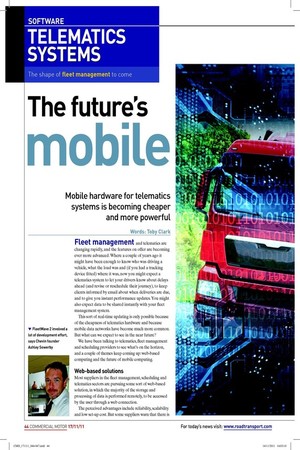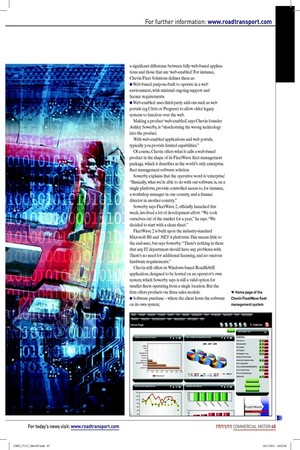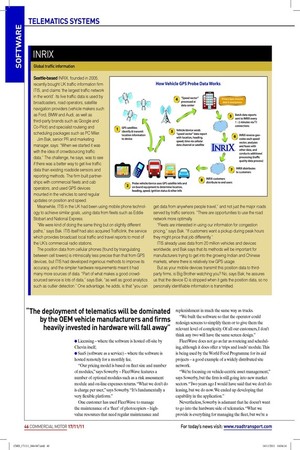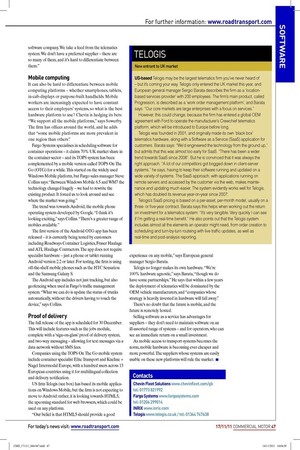The future’s
Page 35

Page 36

Page 37

Page 38

If you've noticed an error in this article please click here to report it so we can fix it.
obile
Mobile hardware for telematics systems is becoming cheaper and more powerful
Words: Toby Clark
Fleet management and telematics are changing rapidly, and the features on offer are becoming ever more advanced. Where a couple of years ago it might have been enough to know who was driving a vehicle, what the load was and (if you had a tracking device itted) where it was, now you might expect a telematics system to let your drivers know about delays ahead (and revise or reschedule their journey), to keep clients informed by email about when deliveries are due, and to give you instant performance updates. You might also expect data to be shared instantly with your leet management system.
This sort of real-time updating is only possible because of the cheapness of telematics hardware and because mobile data networks have become much more common. But what can we expect to see in the near future?
We have been talking to telematics, leet management and scheduling providers to see what’s on the horizon, and a couple of themes keep coming up: web-based computing and the future of mobile computing.
Web-based solutions
Most suppliers in the leet management, scheduling and telematics sectors are pursuing some sort of web-based solution, in which the majority of the storage and processing of data is performed remotely, to be accessed by the user through a web connection.
The perceived advantages include reliability, scalability and low set-up cost. But some suppliers warn that there is a signiicant difference between fully web-based applications and those that are ‘web-enabled’. For instance, Chevin Fleet Solutions deines them as: ● Web-based: purpose-built to operate in a web environment, with minimal ongoing support and licence requirements.
● Web-enabled: uses third-party add-ons such as web portals (eg Citrix or Progress) to allow older legacy systems to function over the web.
Making a product ‘web-enabled’, says Chevin founder Ashley Sowerby, is “shoehorning the wrong technology into the product.
With web-enabled applications and web portals, typically you provide limited capabilities.” Of course, Chevin offers what it calls a web-based product in the shape of its FleetWave leet management package, which it describes as the world’s only enterprise leet management software solution.
Sowerby explains that the operative word is ‘enterprise’. “Basically, what we’re able to do with our software is, on a single platform, provide controlled access to, for instance, a workshop manager in one country, and a inance director in another country.” Sowerby says FleetWave 2, oficially launched this week, involved a lot of development effort. “We took ourselves out of the market for a year,” he says. “We decided to start with a clean sheet.” FleetWave 2 is built upon the industry-standard Microsoft IIS and .NET 4 platforms. This means little to the end-user, but says Sowerby: “There’s nothing in there that any IT department should have any problems with. There’s no need for additional licensing, and no onerous hardware requirements.” Chevin still offers its Windows-based RoadBASE application, designed to be hosted on an operator’s own system, which Sowerby says is still a valid option for smaller leets operating from a single location. But the irm offers products via three sales models: ● Software purchase – where the client hosts the software on its own system; ● Licensing – where the software is hosted off-site by Chevin itself; ● SaaS (software as a service) – where the software is hosted remotely for a monthly fee.
“Our pricing model is based on leet size and number of modules,” says Sowerby – FleetWave features a number of optional modules such as a risk assessment module and on-line expenses returns. “What we don’t do is charge per user,” says Sowerby. “It’s fundamentally a very lexible platform.” One customer has used FleetWave to manage the maintenance of a ‘leet’ of photocopiers – highvalue resources that need regular maintenance and replenishment in much the same way as trucks.
“We built the software so that the operator could redesign screens to simplify them or to give them the relevant level of complexity. Of all our customers, I don’t think any two will have the same screen design.” FleetWave does not go as far as routeing and scheduling, although it does offer a ‘trips and loads’ module. This is being used by the World Food Programme for its aid projects – a good example of a widely distributed site network.
“We’re focusing on vehicle-centric asset management,” says Sowerby, but the irm is still going into new market sectors. “Two years ago I would have said that we don’t do leasing, but we do now. We ended up developing that capability in the application.” Nevertheless, Sowerby is adamant that he doesn’t want to go into the hardware side of telematics. “What we provide is everything for managing the leet, but we’re a software company. We take a feed from the telematics system. We don’t have a preferred supplier – there are so many of them, and it’s hard to differentiate between them.”
Mobile computing
It can also be hard to differentiate between mobile computing platforms – whether smartphones, tablets, in-cab-displays or purpose-built handhelds. Mobile workers are increasingly expected to have constant access to their employers’ systems, so what is the best hardware platform to use? Chevin is hedging its bets: “We support all the mobile platforms,” says Sowerby. The irm has ofices around the world, and he adds that “some mobile platforms are more prevalent in one region than others”.
Fargo Systems specialises in scheduling software for container operations – it claims 70% UK market share in the container sector – and its TOPS system has been complemented by a mobile version called TOPS On The Go (OTG) for a while. This started on the widely used Windows Mobile platform, but Fargo sales manager Steve Collins says: “Between Windows Mobile 6.5 and WM7 the technology changed hugely – we had to rewrite the existing product. It forced us to look around and see where the market was going.” The trend was towards Android, the mobile phone operating system developed by Google. “I think it’s looking exciting,” says Collins. “There’s a greater range of mobiles available.” The irst version of the Android OTG app has been released – it is currently being tested by customers including Roadways Container Logistics, Fraser Haulage and ATL Haulage Contractors. The app does not require specialist hardware – just a phone or tablet running Android version 2.2 or later. For testing, the irm is using off-the-shelf mobile phones such as the HTC Sensation and the Samsung Galaxy S.
The Android app includes not just tracking, but also geofencing when used in Fargo’s trafic management system. “What we can do is update the status of trunks automatically, without the drivers having to touch the device,” says Collins.
Proof of delivery
The full release of the app is scheduled for 30 December. This will include features such as the jobs module, complete with a ‘sign-on-glass’ proof of delivery system, and two-way messaging – allowing for text messages via a data network without SMS fees.
Companies using the TOPS On The Go mobile system include container specialist Elite Transport and Kuehne + Nagel Intermodal Europe, with a hundred users across 13 European countries using it for multilingual collection and delivery notiication.
US irm Telogis (see box) has based its mobile applications on Windows Mobile, but the irm is not expecting to move to Android: rather, it is looking towards HTML5, the upcoming standard for web browsers, which could be used on any platform.
“Our belief is that HTML5 should provide a good experience on any mobile,” says European general manager Sergio Barata.
Telogis no longer makes its own hardware. “We’re 100% hardware agnostic,” says Barata, “though we do have some partnerships.” He says that within a few years the deployment of telematics will be dominated by the OEM vehicle manufacturers, and “companies whose strategy is heavily invested in hardware will fall away”.
There’s no doubt that the future is mobile, and the future is remotely hosted.
Selling software as a service has advantages for suppliers – they don’t need to maintain software on an ill-assorted range of systems – and for operators, who can see an immediate return on a small investment.
As mobile access to transport systems becomes the norm, mobile hardware is becoming ever cheaper and more powerful. The suppliers whose systems are easily usable on these new platforms will rule the market. ■










































